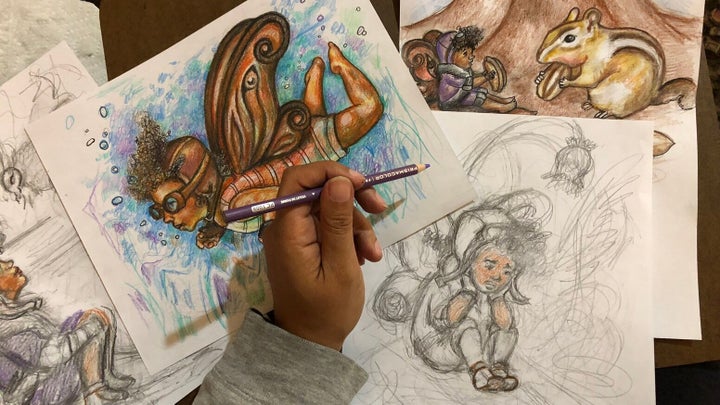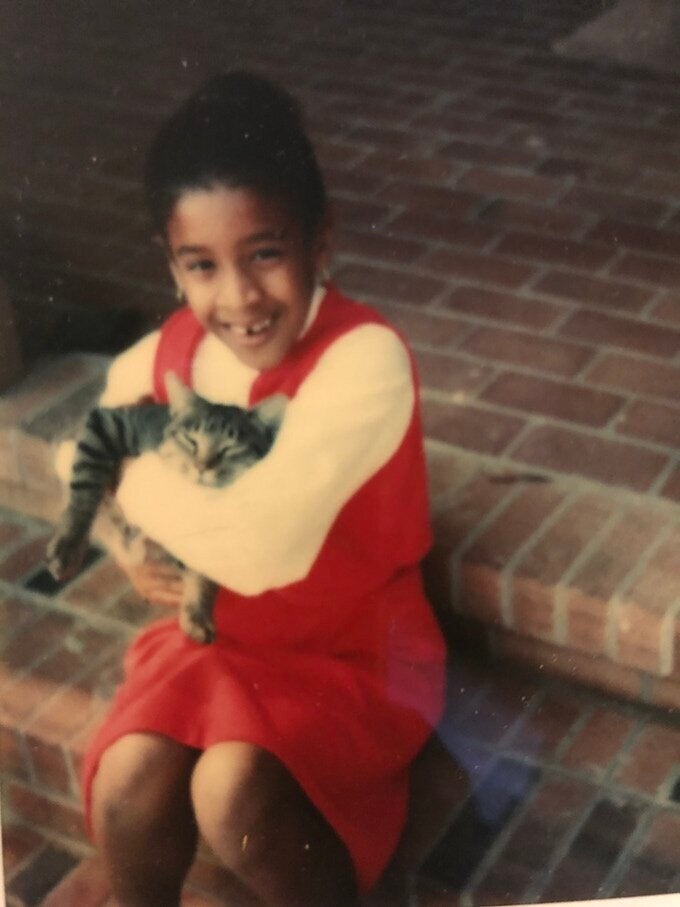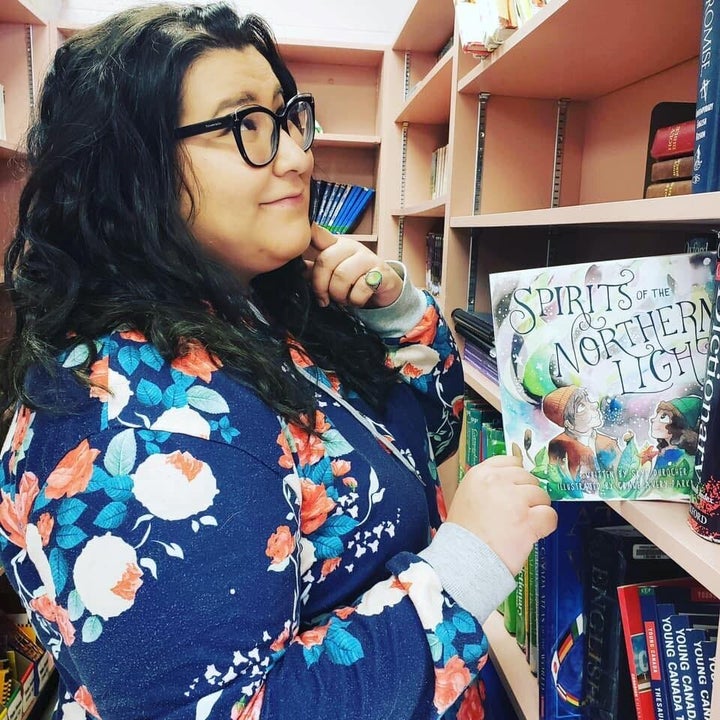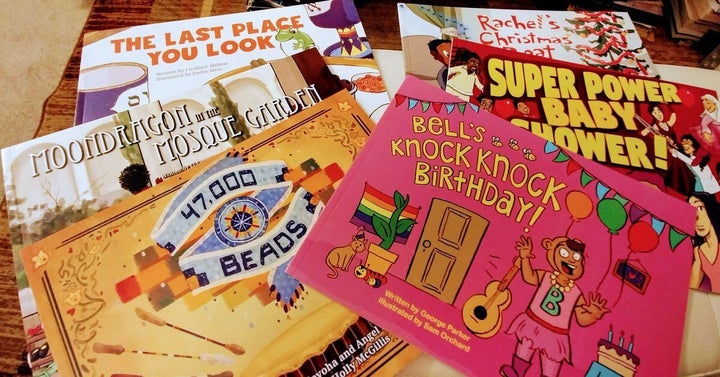
“Auntie E, why are there no heroes who look like me?”
That question was posed to Erica Ramsey-Bowen by her 10-year-old niece. Ramsey-Bowen wasn’t surprised. It was something she had wondered since she was a kid herself and the only book with a Black protagonist was The Snowy Day by Ezra Jack Keats.
As Harry Potter fans, the two looked for fantasy books featuring brown characters to no avail. But Ramsey-Bowen wasn’t going to let that be a problem.
Now set for publication next year, Ramsey-Bowen’s book The Little Fairy Who Wasn’t A Fairy serves as a reminder of the difference a story can make for children themselves.

“It’s 2019 … how come little Black kids don’t have adventures? Every child has adventures,” she told HuffPost Canada.
As a popular infographic based on U.S. statistics depicts, children’s books published in 2018 greatly underrepresent people of colour. White characters made up 50 per cent of characters, while 23 per cent were visible minorities. In fact, books with animals in them far outweighed the number of books featuring Black, Indigenous, Latinx, Asian, or Pacific Islander characters combined.
But the diversity gap in kids lit isn’t just a problem on the page. It affects those writing the stories, too. From the Cooperative Children’s Book Center’s (CCBC) study, only 21 per cent of U.S. kids’ books published last year were written by people of colour.
Ramsey-Bowen almost didn’t have a happy ending for her book; she felt disillusioned by both the lack of people of colour in books and those writing them for big press. She turned to crowdfunding to get her project off the ground.
Although there’s no Canadian equivalent for CCBC’s data, reading diverse books is a big interest for many Canadian families. About 86 per cent of Canadian kids ages six to 17 are reading for pleasure, a 2017 Scholastic survey found. The same report states that when parents were also asked, one in five families are looking for diversity in their books; the majority search for ethnic and cultural representation, followed by characters with disabilities.
So, with the demand for faces of colour on pages, what role do parents play in supporting the people of colour making kids lit?
There’s an imbalance between white authors and authors of colour
Brampton, Ont. author Jael Richardson noticed that even within diverse books, there can be a lack of depth. She sees an issue when parents buy books just because they features characters of colour, without considering the author’s identity.
“There are very few writers of colour, who are able to make a living off their writing in the children’s book industry. There are far more white writers who are able to do that,” she points out.
As a mother of a 10-year-old boy, she knows all too well that it can add to a parent’s workload to look up an author for every book they encounter. It’s especially challenging for her to find Black male authors for her son to read. Still, she urges families to be conscientious shoppers and check the identities of those behind the diverse books.
WATCH: Non-profit organization publishes educational books for children facing natural disasters. Story continues below.
“I know we’re asking a lot of parents and I don’t mean to push more guilt on parents at all,” she said. “I think it’s really worthwhile to think, not just about what’s happening on the surface of the book, but what’s happening behind the scenes and who we are supporting.”
Toronto author Troy Jackson wrote Moondragon In The Mosque Garden with his husband, El-Farouk Khaki, for their two-year-old. For Jackson, who identifies as Afro-Indigenous, Muslim, and queer, it was important that they were the ones who told the story their son would eventually read.
“We often have people tell our story for us. I think the danger in that is that the nuances that would be in those stories, when told by people who are the subjects, get missed,” Jackson said.
This doesn’t mean authors should steer clear of writing identities other than their own. But without writers of colour and queer writers, Jackson said, “we get Stonewall the movie,” in reference to how the 2015 film received criticism for erasing the contributions of trans women of colour at the 1969 Stonewall riots.
How authors of colour share cultural nuances
When parents put in the extra effort to find diverse authors, it pays off for everyone.
Elementary school teacher Nadia L. Hohn is the author of several children’s books, including the Malaika series. Throughout her work, she aims to tell the stories she wanted to see as a Black Canadian girl with Jamaican immigrant parents.
In the Malaika books, the protagonist’s mother works in Canada to send money back home.

“I have heard people say there is nothing like my stories … this is such a common occurrence in the Caribbean immigration story (including in my own family) as well as for many immigrant children around the world,” she wrote to HuffPost Canada.
She’s found that not only are parents of colour interested in books about unsung Black heroes from a Black author, but white parents are, too. For example, children who have heard about Harriet Tubman in school may be curious to read more about her.
Sharing cultural nuances is something Skye Durocher has accomplished, too. The 29-year-old Métis author is from Fishing Lake Metis Settlement in Alberta. Durocher wrote and self-published her first book Spirits of the Northern Lights, which follows the life of a girl named Cora and the lessons her grandparents teach her.

Like Ramsey-Bowen, Durocher had a lack of representation in her own childhood. Animals on the shelves—Franklin, Arthur, and Clifford the Big Red Dog—were easier to find than anyone Indigenous.
“Growing up, [I felt] that there was something wrong with me because I didn’t see myself in media. Nobody looked like me, came from a reserve or settlement,” she said.
Drawing from her lived experiences and stories shared by her family, Durocher’s book touches on cultural aspects that she felt were important to have in a story with Indigenous characters. One way was through narrative structure that shows Cora in all her life stages, which Durocher says mirrors traditional storytelling.
#OwnVoices, small press: how parents find authors of colour
Finding diverse books has been made easier, thanks to initiatives like We Need Diverse Books, as well as databases like the Social Justice and Diversity Book Bank by Canadian Children’s Book Centre.
But how can parents figure out which ones are by diverse writers and illustrators? All writers who spoke to HuffPost Canada said social media and online searches are essential. Author Pat Nicholson said many, like herself, are on Twitter. Not only do authors share their work, but readers often find new books through recommendation threads.
A hashtag started specifically for diverse kids lit authors is #OwnVoices, which promotes marginalized writers whose main characters reflect their own identities.
For parents short on time, curated collections like Brown Bookshelf can be a huge help.
“There are very few writers of colour, who are able to make a living off their writing in the children’s book industry. There are far more white writers who are able to do that.”
- Jael Richardson
Small publishing is leading the way for diverse kids’ literature. As the CCBC acknowledges, these publishers had a positive effect on their statistics. Jackson’s book was published after he was approached by Canadian micro-press Flamingo Rampant, which is devoted to LGBTQ+ and POC representation in kids lit.

“Small publishers are the ones taking chances … you’d be surprised at the amount of things people are doing on their own,” Jackson said.
But because small press is a popular route for many writers of diversity, finding their work on big box shelves can be a challenge.
Bookshops with intentional collections are part of the solution. Toronto’s Glad Day, which is co-owned by Jackson (alongside his husband and several others) as well as A Different Booklist stock diverse books by authors of lived experience for parents to peruse. Many also host readings and special events, where kids can listen to the adults behind their favourite stories bring them to life.
Another place books about and by people of colour can be found is at a book festival. Structural imbalances and lack of author exposure in the book industry are part of the reason Richardson founded FOLD, the Festival of Literary Diversity in Brampton, Ont. The annual event has a new addition this year: FOLD Kids Book Fest, of which Hohn is a program coordinator. The two plan for the kids’ event to be an opportunity for families to meet authors and illustrators in-person.
Still, nothing beats a recommendation from a friend. Booknet Canada survey found that word-of-mouth is the most popular method Canadians discover books.
It’s here that Hohn hopes more parents pay it forward. After finding books their kids love, she hopes they engage in diverse author promotion over social media, mailing lists and when talking to fellow parents.
The readers surveyed by Booknet Canada, of which over half were moms and dads, were most likely to borrow from a library for physical reading material.
Getting work by diverse authors in libraries is something Durocher says parents need to advocate for. She finds that school libraries are especially a great way to introduce readers to Indigenous literature.
Schools close to her home community have asked her to read to students.

There, she’s able to see the impact both her work and her identity has on kids who look like her.
“They just had so many questions. I was only supposed to be there for about two hours. I think that kept me there for almost the whole day,” she said. “They see that I physically look and talk like I’m from the bush … I think it’s something really positive for them.”
Also on HuffPost: